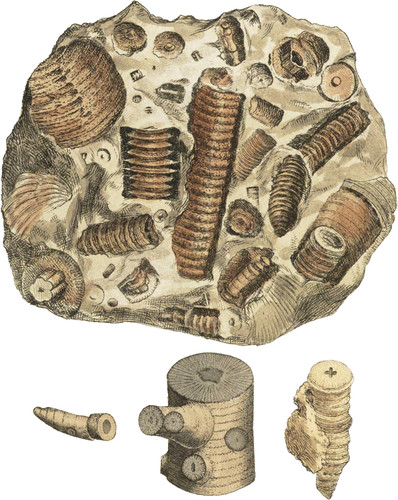 Enlarge
Enlarge
British Mineralogy
Quartzose Encrini, or Encrini in Chert
- Div. 2. Imitative.
Hornstone or Chert is found in many parts of Great Britain; it occurs in several of the Limestone strata, when it often surrounds and penetrates the fossils contained, in them. The Encrini (formerly called Entrochi) which characterize the first Floetz or Transition Limestone of Werner, (but which according to Mr. Farey occur also in the Third Limestone of Derbyshire,) are very frequently imbedded or filled with Chert or Quartz, winch is rendered very distinct, when by subterraneous decompositions or exposure to the atmosphere the Carbonate of Lime has been carried away. Specimens in this state have been long collected and vulgarly called Screwstones, although their grooves are not spiral. Mr. Farey brought me some specimens he found in walls near Ashover in Derbyshire, where vast quantities are picked out of t he decayed Limestone by the farmers. Some of these specimens differ in some parts but little from Flint, while others have the peculiar characterise opacity of Chert. I have figured at the bottom of the plate two or three Encrini in Limestone, to show lie external form, as the siliceous casts show the internal; the right hand specimen is a rare variety with a four-lobed aperture through each joint; the middle figure is of a branched specimen from Northumberland with which I was favoured by the late Lord Ansley. Near this is figured what appears to be the termination of a branch; it was brought me from Walsingham in Durham. I do not know that a termination has been noticed by any other author. The branched specimen shows the lobes in the perforation to be fewer in the branches than in the main stem. For a further account of the numerous species of these curious fossils, I must beg to refer to Mr. Parkinson’s Organic Remains, vol. ii.

